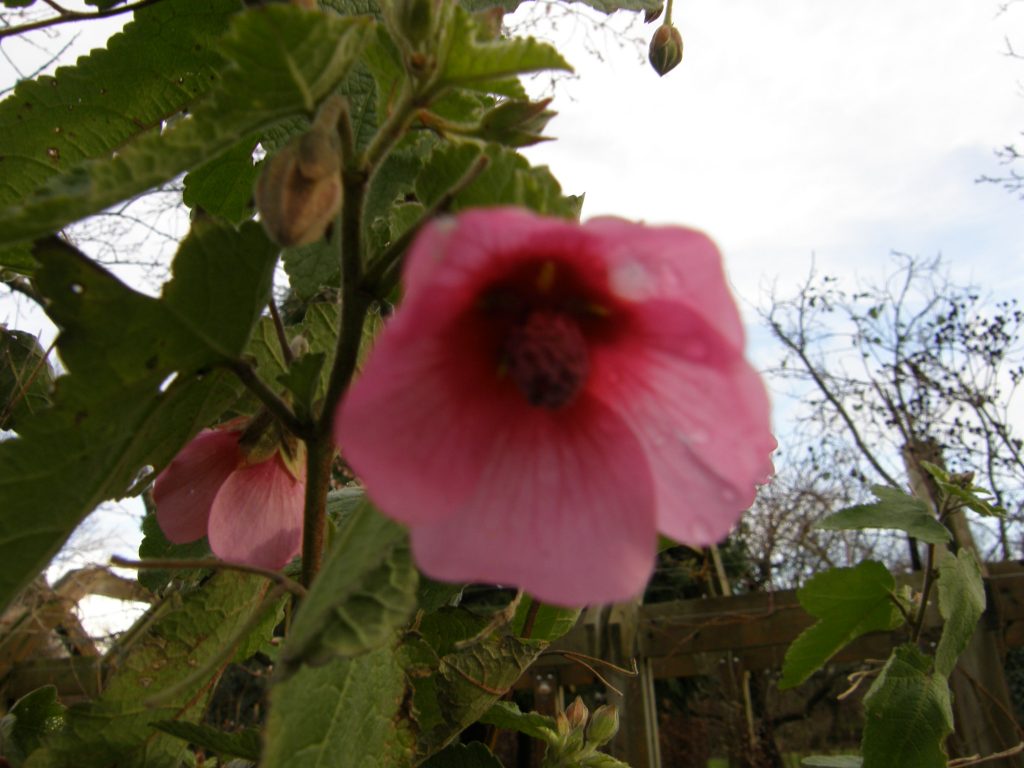 Gardening in winter is always a bit hit and miss. Sometimes on a wet grey day I look out at the soggy lawn and bedraggled browned stems, sorry remnants of summer and autumn’s grand finale and think, Nah! Not going out today.
Gardening in winter is always a bit hit and miss. Sometimes on a wet grey day I look out at the soggy lawn and bedraggled browned stems, sorry remnants of summer and autumn’s grand finale and think, Nah! Not going out today.
Then I might take a tour round the garden and notice all the weeds that have grown undercover through the autumn, now exposed; Ground Ivy, Creeping Buttercup, Bittercress, Cuckoo Flower and the winter rosettes of a Willowherb, (possibly Marsh Willowherb). The thought of working the claggy soil with cold wet muddy gloves – Nah!
Other days frost adds glamour to these same browned and faded stems, phlomis and sedum seedheads triumphant in their temporary sparkly attire. Then back to soggy and dull during the next wet spell.
Yesterday I briefly ventured into the fray, the frost didn’t leave the main border all day in places. The frosty crust did make it slightly easier to walk on the lawn which had had its first inundation of the winter season and was a little squelchy under foot.
I tackled a Lonicera japonica Halliana which continues to wind its way insidiously up into trees and along the hedge through the winter, blocking the low sun from some of the beds, starving the iris and others of precious light.
Then it was on to cutting back the various Iris sibirica which are useful during the growing season for their upright stance but now collapsed and splayed out the foliage will smother anything as it emerges. A partial tidy has been done mindful that,
- Small beasties still need winter cover
- Foliage offers some frost protection to other plants around them
We may still be in December but Nah! days and impossible to garden days will soon have us thrust into March when growth begins and tidying proper must be done.
There are drifts of mouldering leaves yet to be swept up (I have done some!) And I have cut back and burned the old peony leaves to try to stop the blight they seem to get in spring. But I will still wish that I had got on more enthusiastically earlier with some of the mundane but necessary tasks.
Waterlogged
The parish field has water in the dips of what may be old ridge and furrow, these pools will ebb and fill until April. One year a family of ducks had time to raise a brood on the temporary waterways. Yesterday a flock of starlings took advantage of this new waterscape briefly, until they sensed me trying to take a picture and off they went in a swirling mass.
Some farmers around the country, but particularly those based on the chalkland sheep grazing / corn economy built systems to flood fields deliberately through the winter. The water raises the temperature which is said to encourage grass into growth earlier and the silt deposited fertilised the fields. The job of the ‘drowners’ who managed these systems was to ensure the water flowed rather than staying in stagnant pools as ours does.
What’s in flower?

Most of the purple-nosed white Cyclamen coum have been in flower for a couple of months, the rich pink cultivars are only just starting to flower. These cyclamen do provide a good value splash of colour through the bleaker months.
Sarcoccoca confusa, Daphne Jacqueline Postill and D odora Aureomarginata show promise of scented flowers soon.
The Prunus subhirtella Autumnalis has the most flowers I’ve seen on it in 5 years. The gusty wind though scattering the tiny flecks of petal far and wide as another squall line moves through.
The Witch Hazel remains firmly budded, here and there just a glimpse of yellow. My parents in Somerset have one already in full beribboned flower.
Bob Brown in a talk he gave last Autumn extolled the virtues of Anisodontea El Royo (Or El Rayo), this pink mallow flowered shrub from South Africa does remain evergreen and flower on and on. Can be borderline hardy as I lost the woodier parent when we had a few days of -7C this spring. Seems to take easily from late summer cuttings and I think I prefer the younger growth, when woody it loses its litheness!
In the unheated greenhouse a couple of abutilon still flower fitfully. The Acacia dealbata I had high hopes of a spring show from is however moping and dropping leaves not a good sign.
Hellebores various are lining themselves up for flowering, one H argutifolius has been flowering through the autumn, the other plant is still in bud. A H niger cross, Snow Love, looks like it will be the first hybrid in flower well ahead of the orientalis.

Babington’s Leek and Elephant Garlic leaves are thrusting through the soil enthusiastically.The first daffs up are the scented Trevithian, although we have the roughest weather yet to come and quite a wait to see the flowers.
